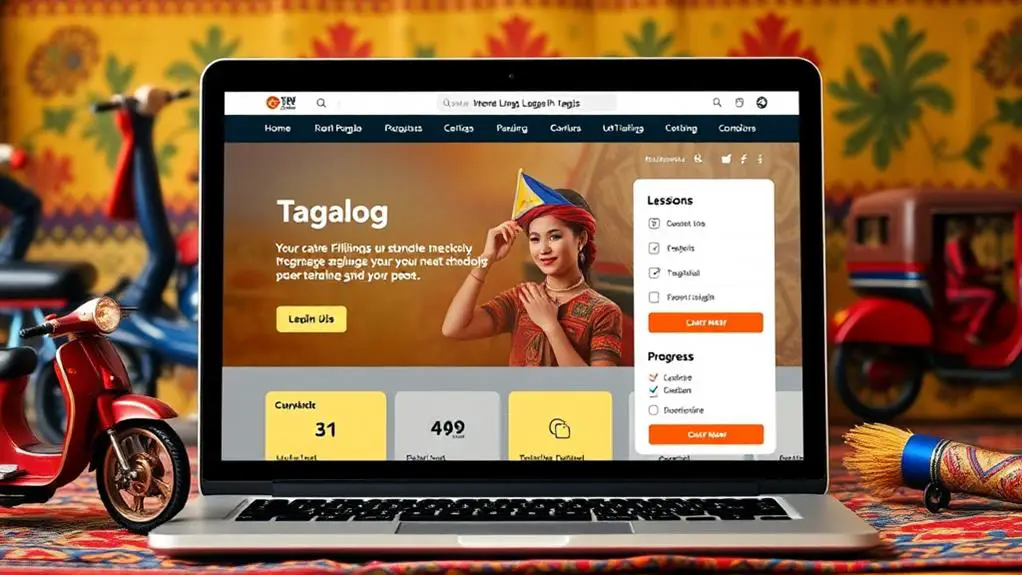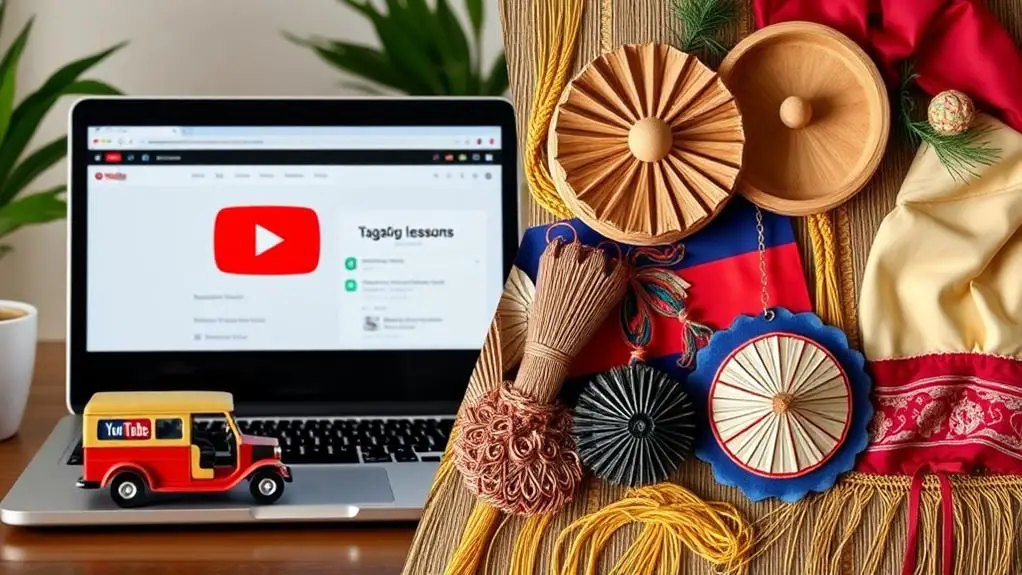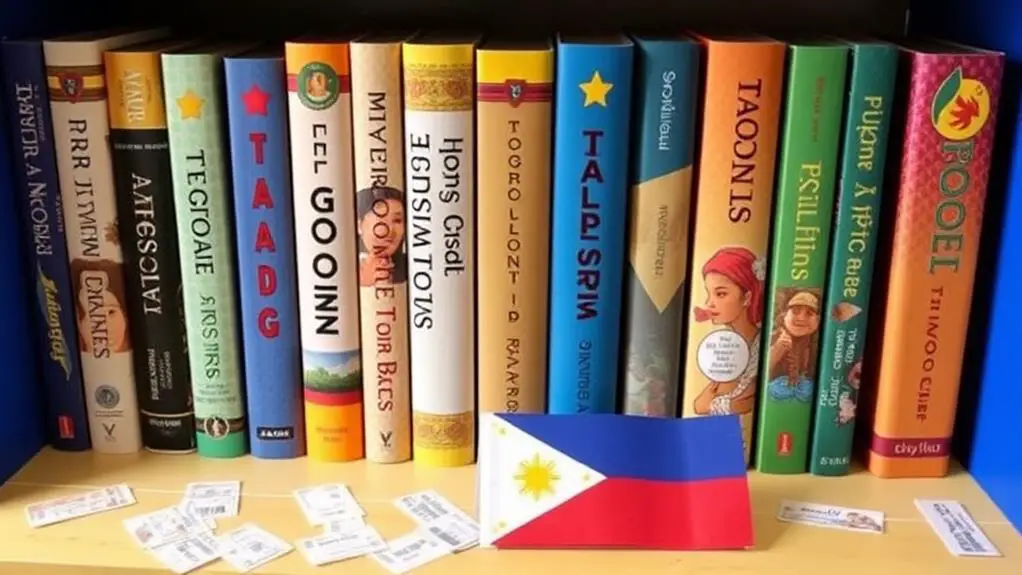Structured Online Learning Platforms are an excellent starting point for self-study. Fluent in Three Months, FilipinoLessons.com, and Talk Tagalog offer comprehensive lessons catering to diverse learning styles and preferences.
Language Learning Apps and Podcasts can supplement your studies. FilipinoPod101, Pimsleur Tagalog, and Memrise provide interactive lessons and exercises to enhance your language skills.
Cultural Immersion is essential to enrich your understanding of Tagalog. Watch Filipino films, listen to Filipino music, and attend community gatherings to gain a deeper appreciation of the culture.
Personalized Learning with native speaker tutors can help you improve your speaking and listening skills.
Social Media Resources, such as daily language tips, can also support your learning journey.
Remember, these resources are just the beginning. Consistency and dedication are key to mastering Tagalog.
Structured Online Learning Platforms

Structured online learning platforms streamline Tagalog language learning, boosting progress and confidence. These platforms cater to diverse learning styles and preferences, offering a comprehensive approach to learning Tagalog.
Fluent in Three Months by Benny The Irish Polyglot starts learners speaking Tagalog from day one, providing free resources and a premium option for advanced materials.
FilipinoLessons.com features structured lessons on vocabulary and grammar, points-based activities, and a community forum for learners to engage and seek support.
Talk Tagalog offers user-friendly lessons, immersive podcasts for listening practice, and interactive quizzes.
These platforms not only focus on language learning but also incorporate cultural insights, enhancing understanding and appreciation of Filipino heritage alongside language acquisition.
By leveraging these resources, learners can develop a solid grasp of Tagalog grammar and vocabulary, paving the way for effective communication in Tagalog.
Language Learning Apps and Podcasts
Master Tagalog at Your Own Pace
To learn Tagalog comprehensively, FilipinoPod101 is an excellent choice, offering lessons for all levels, accessible as a podcast and on their website. This resource provides a structured approach to learning the language.
For a user-friendly approach, Pimsleur Tagalog teaches practical phrases to get you speaking in 30 days. Although it relies heavily on English examples, this resource is effective for beginners.
To enhance conversational skills and cultural understanding, Talk Tagalog Podcast is an engaging resource that focuses on conversational Filipino. It covers various topics, making it an excellent supplement to language courses.
For interactive learning, Memrise is a free, gamified flashcard approach that lets you learn Tagalog vocabulary through community-driven courses. This resource is ideal for those who enjoy interactive learning.
Lastly, Glossika Tagalog emphasizes high repetition of phrases to aid comprehension and fluency. To achieve the best results, daily practice is required. This resource is suitable for those who can commit to regular language practice.
These language learning apps and podcasts provide a range of options to learn Tagalog, offering flexibility and convenience to fit your language courses and Tagalog lesson schedule.
Cultural Immersion and Insights

Cultural Immersion and Insights
Cultural immersion is a powerful tool to enhance your Tagalog language skills and gain a deeper understanding of the Filipino way of life.
By engaging with various aspects of the culture, you'll develop a more nuanced appreciation for the language and its nuances.
Cultural Immersion Activities and Their Benefits
Watching Filipino films and series enhances language skills, provides cultural context, and offers insights into Filipino life.
For instance, watching a movie like "Honor Thy Father" (2015) can help you understand the nuances of Tagalog language and Filipino family dynamics.
Listening to Filipino music immerses learners in contemporary Filipino culture and highlights language nuances.
OPM (Original Pilipino Music) artists like Moira Dela Torre and Ben&Ben can help you appreciate the rhythm and melody of the Tagalog language.
Participating in community gatherings fosters real-life conversational practice, cultural appreciation, and language acquisition.
Joining events like the Filipino Independence Day celebration can help you practice your Tagalog conversation skills and learn about Filipino customs.
Additional Cultural Immersion Strategies
Following Filipino language resources on social media enriches your cultural understanding and engagement with the language.
For example, following Filipino language learning pages on Instagram can provide you with daily language tips and cultural insights.
Incorporating cultural narratives into your language learning routine further enriches your cultural understanding and engagement with the language.
Reading Filipino novels like "Noli Me Tangere" by Jose Rizal can help you understand the historical and cultural context of the Tagalog language.
Combining Cultural Immersion Activities
By combining these activities, you'll gain a more comprehensive understanding of the Filipino culture and improve your Tagalog language skills.
This comprehensive approach will help you develop a deeper appreciation for the language and its nuances, leading to more effective communication and cultural understanding.
Personalized Learning Through Tutors
Personalized learning is key to mastering the Filipino language. With ITalki, you can connect with native speakers or professional teachers who tailor lessons to your needs and interests. You can filter tutors by language proficiency, availability, and rate to find the best fit for your budget and learning style.
Targeted guidance helps you overcome language barriers. Personalized lessons on ITalki allow you to focus on specific areas of difficulty or interest, such as conversational Tagalog, reading comprehension, or pronunciation.
You'll receive targeted feedback and guidance, enhancing your motivation and engagement in the language learning process.
Language exchange opportunities facilitate peer learning. The platform enables you to practice Tagalog with peers while helping others learn your native language.
ITalki's review and rating system ensures you make informed choices when selecting a tutor, giving you confidence in your decision.
Personalized lessons cater to your unique needs and goals. With ITalki, you'll discover the best way to learn Tagalog through personalized lessons that address your specific requirements.
Social Engagement and Community Building

Social engagement and community building are crucial for effective Tagalog learning. Engaging in conversations with friends and family at Filipino gatherings provides real-life practice and immediate feedback. For instance, attending a Filipino potluck dinner allows you to practice your Tagalog skills in a casual setting.
Utilize social media platforms to access language learning resources. Following language learning pages and accounts on social media provides regular tips, updates, and community interactions that foster motivation and support. For example, following a Tagalog language learning Facebook page can provide you with daily language tips and exercises.
Join online forums or communities dedicated to Tagalog learning. These communities encourage collaboration and sharing of resources, enriching your learning experience through peer support. For instance, joining a Reddit community for Tagalog learners allows you to connect with other learners, share resources, and get feedback on your language skills.
Participate in live sessions or Q&A opportunities with native speakers or experienced learners. This helps deepen your understanding and gain practical insights into language use and cultural nuances. For example, attending a live webinar with a native Tagalog speaker can provide you with insights into cultural nuances and language usage.
Develop a growth mindset when practicing with native speakers. Building a thick skin and approaching conversations with determination are essential, as Filipino culture values honesty, which may include candid critiques of your language skills during practice.
Remember that constructive criticism is an opportunity to improve your language skills.
Newsletters and Learning Materials
Tagalog learning newsletters, like Barkada, provide a valuable resource for language learners by offering exclusive updates, offers, and engaging Filipino stories that boost language learning enthusiasm.
Stay Informed About New Materials and Tools
Tagalog learning newsletters keep you informed about new materials and tools to enhance your language skills. By subscribing, you'll receive exclusive updates and offers on new learning materials, promotions, and discounts, making language learning more accessible.
Discover Comprehensive Resources
These newsletters provide a range of resources, including books, videos, and apps, to help you learn Tagalog effectively. You'll have access to a variety of formats and tools to find what works best for your learning style.
Gain Cultural Insights
Tagalog learning newsletters offer cultural insights, allowing you to gain a deeper appreciation of Filipino heritage and culture, which is essential for understanding the language. Through these newsletters, you'll explore different aspects of Filipino culture and traditions.
Take Advantage of Regular Promotions and Offers
YouTube Resources for Tagalog Learning

YouTube channels offer a valuable resource for learning Tagalog. Channels like Filipino Folk Songs for Kids and Pinoy BK Channel cater to young learners, providing animated Tagalog folk songs and educational animations that make language learning fun and culturally enriching.
These channels promote the Tagalog language and culture among young audiences, enhancing their learning experience through visual and auditory aids.
Mga Kwentong Tagalog offers read-aloud children's storybooks in Tagalog, helping to develop listening skills and comprehension.
Many YouTube channels encourage viewer interaction and participation, making language acquisition more dynamic and enjoyable.
Tagalog Language Research and Studies
Tagalog language research plays a crucial role in understanding the complexities of the language. Phonology research, for instance, has provided valuable insights into speech and language disorders. Studies have shown that Tagalog phonology can help develop effective communication strategies for individuals with speech disorders.
Standardized practices are essential in speech therapy, particularly in Tagalog language contexts. The Philippines' Speech-Language Pathology Act emphasizes the importance of standardized practices to ensure effective communication. This is crucial for learning the language and addressing speech disorders.
Communication access is another area where research has made significant contributions. University of the Philippines students have developed an initial Augmentative and Alternative Communication board for Tagalog speakers. This innovation enhances communication access and promotes language preservation.
Language preservation is critical, especially in early grade reading instruction and assessment. US AID research highlights the importance of local languages, including Tagalog, in education. Understanding Tagalog grammar rules is essential for effective communication and language preservation.
These studies demonstrate the significance of research in advancing our understanding of the Tagalog language. By exploring these resources, you'll gain a deeper appreciation for the complexities of the language and be better equipped to learn and communicate effectively in Tagalog.
Tagalog Language Books and Reviews

Mastering the Tagalog language requires the right resources. Five essential books stand out for their ability to guide learners.
Elementary Tagalog is a comprehensive resource covering grammar, vocabulary, and pronunciation, making it suitable for learners at various levels.
For beginners, Tagalog for Beginners focuses on practical language use and incorporates cultural notes, ideal for those new to the language.
To gain a deeper understanding of the language, Essential Tagalog Grammar provides in-depth explanations of grammatical features with clear examples, making it a valuable resource for serious learners.
To improve reading skills, Tagalog Short Stories for Beginners offers 20 engaging stories with simplified language, vocabulary lists, and comprehension questions, enhancing reading skills in a fun way.
Can Learning Tagalog Numbers Be Simplified Using Self-Study Resources?
Learning Tagalog numbers can be straightforward with the right tools. Online platforms, videos, and practice exercises make self-study effective. For beginners, there are plenty of resources where “basic tagalog numbers explained” offer an easy-to-follow approach, helping you master counting in no time and boosting your confidence in everyday conversations.
Effective Tagalog Language Learning Strategies
Mastering Tagalog requires a strategic approach to learning. To accelerate progress, adopt effective Tagalog language learning strategies.
Practice Speaking Early: Engage in conversations from the start to build confidence in speaking Tagalog. This helps overcome the fear of speaking and develops pronunciation skills. For instance, try speaking with a language exchange partner or recording yourself speaking in Tagalog.
Incorporate Cultural Context: Learn Tagalog through cultural narratives, films, and music to gain insights into Filipino traditions and lifestyle. This approach helps learners connect with the language on a deeper level. For example, watch Filipino movies with English subtitles or listen to OPM (Original Pilipino Music) to improve listening skills.
Set Realistic Goals: Establish achievable learning objectives to maintain motivation and consistency. Break down larger goals into smaller, manageable tasks to track progress. For instance, aim to learn five new vocabulary words daily or practice writing in Tagalog for 15 minutes each day.
Practice with Native Speakers: Connect with native speakers through platforms like italki or Preply for personalized practice. This significantly improves pronunciation and conversational fluency. For example, schedule weekly conversations with a native speaker to discuss topics like daily routines or favorite hobbies.
Frequently Asked Questions
What Are the Resources for Learning Tagalog?
Language Apps: Structured lessons and grammar guides are available through Tagalog language apps like FilipinoLessons.com and FilipinoPod101. These apps provide a comprehensive learning experience, covering various aspects of the language.
Cultural Immersion: To improve your listening and speaking skills, try listening to Tagalog podcasts that discuss various topics, such as news, culture, and history.
Additionally, practice conversations with native speakers to get accustomed to the natural flow and rhythm of the language.
Pronunciation Practice: Forvo is an online resource that allows you to perfect your pronunciation by listening to native speakers and comparing your speech with theirs.
What Is the Best Website to Learn Tagalog?
Finding the Best Website to Learn Tagalog
When searching for the best website to learn Tagalog, consider your learning style.
Do you prefer interactive games, online courses, or grammar guides?
If you're a beginner, FilipinoLessons.com is a good option, offering structured lessons and a community forum.
For a more immersive experience, Talk Tagalog provides podcasts and quizzes.
Ultimately, choose a website that keeps you engaged and motivated to learn the Tagalog language.
What Is the Easiest Way to Learn Filipino?
Combining effective techniques is key to learning Filipino efficiently. To overcome common language challenges, using spaced repetition helps solidify vocabulary, while active listening improves pronunciation.
Immerse yourself in the culture to enhance retention. Watching Filipino films exposes you to conversational dialogue, and listening to OPM music helps you get accustomed to the sounds and rhythms of the language.
Practice speaking with native speakers from day one to build confidence and fluency. Focus on common phrases and situations, such as greetings, introductions, and ordering food.
This practical approach enables you to apply your knowledge in real-life scenarios.
What Is the Alternative to Duolingo Tagalog?
Looking for an alternative to Duolingo Tagalog?
If you prefer traditional learning methods, FilipinoPod101 and Transparent Language offer comprehensive online courses. These platforms provide structured lessons and materials to help you learn Tagalog at your own pace.
For a more interactive approach, Memrise's community-driven flashcards are a great choice. You can create digital flashcards with Tagalog words and phrases and engage with other learners to reinforce your learning.
If speaking is your priority, Pimsleur Tagalog and italki's language exchange platform with native tutors can help. Pimsleur focuses on listening and speaking skills, while italki connects you with native Tagalog speakers for personalized language practice.
You can also mix and match these options to find what works best for you.
Experiment with different approaches to find the one that suits your learning style and goals.